
Smokeless stoves
Before entering the house, each one of us get a scarf tied around our necks. This is the Nepali way of expressing gratitude and respect to visitors. Then we climb a notched pole into the house, where I can see the stove and ask my questions.
I am visiting the village of Talphi, in the highlands of Nepal. In this village, Climate Stewards is supporting a project by RIDS Nepal for installing smokeless stoves, and we want to hear from the people what they think about the stoves. I get positive reactions and feedback from almost everyone, and the tying of the scarves is a great example of that.
Life in the house revolves around the stove, where food is prepared up to five times a day. When I ask what people like about the stove, the most frequent response is that now there is no more smoke in the house and they do not have to cough so much. Especially the women are very happy with the stove. They are the ones in their culture who have to cut and carry the firewood. However, because this smokeless stove saves up to 50% on firewood, they now have more time to do other things. They are also very happy with the water tank that is attached to the stove. With this hot water they can wash their hands and hair, brush their teeth and wash their children.
It is clear that the stoves are a success and a blessing. In this way Climate Stewards is supporting these people, who themselves have hardly contributed anything to climate change.





